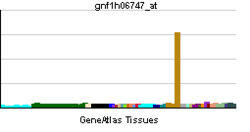- DEFB118
-
Defensin, beta 118 Identifiers Symbols DEFB118; C20orf63; DEFB-18; ESC42; ESP13.6 External IDs OMIM: 607650 HomoloGene: 89041 GeneCards: DEFB118 Gene Gene Ontology Cellular component • extracellular region Biological process • cell-matrix adhesion
• spermatogenesis
• defense response to bacterium
• innate immune responseSources: Amigo / QuickGO RNA expression pattern 
More reference expression data Orthologs Species Human Mouse Entrez 117285 n/a Ensembl ENSG00000131068 n/a UniProt Q96PH6 n/a RefSeq (mRNA) NM_054112 n/a RefSeq (protein) NP_473453 n/a Location (UCSC) Chr 20:
29.96 – 29.96 Mbn/a PubMed search [1] n/a Beta-defensin 118 is a protein that in humans is encoded by the DEFB118 gene.[1][2][3]
References
- ^ Liu Q, Hamil KG, Sivashanmugam P, Grossman G, Soundararajan R, Rao AJ, Richardson RT, Zhang YL, O'Rand MG, Petrusz P, French FS, Hall SH (Sep 2001). "Primate epididymis-specific proteins: characterization of ESC42, a novel protein containing a trefoil-like motif in monkey and human". Endocrinology 142 (10): 4529–39. doi:10.1210/en.142.10.4529. PMID 11564719.
- ^ Yenugu S, Hamil KG, Radhakrishnan Y, French FS, Hall SH (Jun 2004). "The androgen-regulated epididymal sperm-binding protein, human beta-defensin 118 (DEFB118) (formerly ESC42), is an antimicrobial beta-defensin". Endocrinology 145 (7): 3165–73. doi:10.1210/en.2003-1698. PMID 15033915.
- ^ "Entrez Gene: DEFB118 defensin, beta 118". http://www.ncbi.nlm.nih.gov/sites/entrez?Db=gene&Cmd=ShowDetailView&TermToSearch=117285.
Further reading
- van Wetering S, Sterk PJ, Rabe KF, Hiemstra PS (2000). "Defensins: key players or bystanders in infection, injury, and repair in the lung?". J. Allergy Clin. Immunol. 104 (6): 1131–8. doi:10.1016/S0091-6749(99)70004-7. PMID 10588992.
- Gerhard DS, Wagner L, Feingold EA et al. (2004). "The Status, Quality, and Expansion of the NIH Full-Length cDNA Project: The Mammalian Gene Collection (MGC)". Genome Res. 14 (10B): 2121–7. doi:10.1101/gr.2596504. PMC 528928. PMID 15489334. http://www.pubmedcentral.nih.gov/articlerender.fcgi?tool=pmcentrez&artid=528928.
- Kao CY, Chen Y, Zhao YH, Wu R (2003). "ORFeome-based search of airway epithelial cell-specific novel human [beta]-defensin genes". Am. J. Respir. Cell Mol. Biol. 29 (1): 71–80. doi:10.1165/rcmb.2002-0205OC. PMID 12600824.
- Strausberg RL, Feingold EA, Grouse LH et al. (2003). "Generation and initial analysis of more than 15,000 full-length human and mouse cDNA sequences". Proc. Natl. Acad. Sci. U.S.A. 99 (26): 16899–903. doi:10.1073/pnas.242603899. PMC 139241. PMID 12477932. http://www.pubmedcentral.nih.gov/articlerender.fcgi?tool=pmcentrez&artid=139241.
- Schutte BC, Mitros JP, Bartlett JA et al. (2002). "Discovery of five conserved β-defensin gene clusters using a computational search strategy". Proc. Natl. Acad. Sci. U.S.A. 99 (4): 2129–33. doi:10.1073/pnas.042692699. PMC 122330. PMID 11854508. http://www.pubmedcentral.nih.gov/articlerender.fcgi?tool=pmcentrez&artid=122330.
- Deloukas P, Matthews LH, Ashurst J et al. (2002). "The DNA sequence and comparative analysis of human chromosome 20". Nature 414 (6866): 865–71. doi:10.1038/414865a. PMID 11780052.
Categories:- Human proteins
- Chromosome 20 gene stubs
Wikimedia Foundation. 2010.
